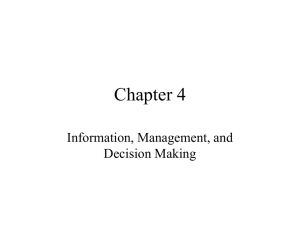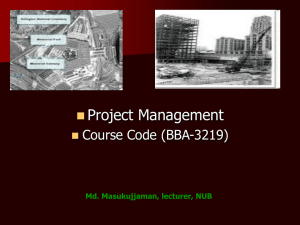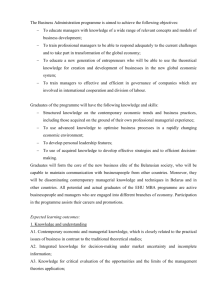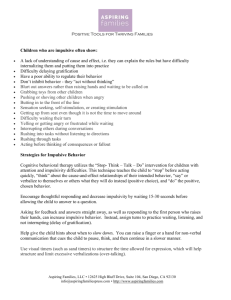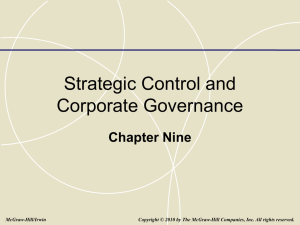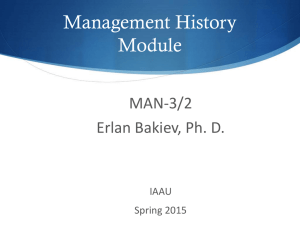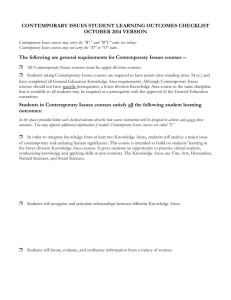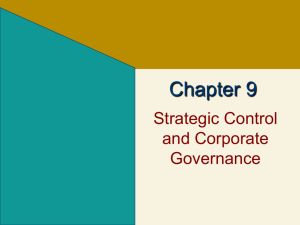Quiz 10 | Chapter 9 Q: Which of the following is NOT one of the steps
advertisement
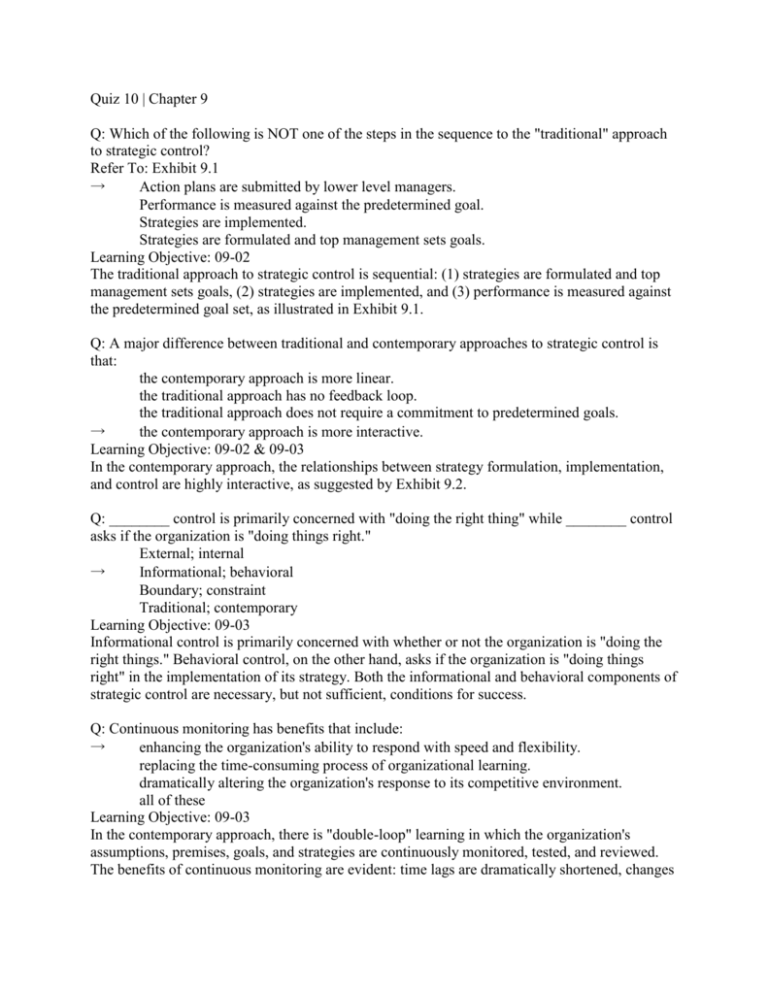
Quiz 10 | Chapter 9 Q: Which of the following is NOT one of the steps in the sequence to the "traditional" approach to strategic control? Refer To: Exhibit 9.1 → Action plans are submitted by lower level managers. Performance is measured against the predetermined goal. Strategies are implemented. Strategies are formulated and top management sets goals. Learning Objective: 09-02 The traditional approach to strategic control is sequential: (1) strategies are formulated and top management sets goals, (2) strategies are implemented, and (3) performance is measured against the predetermined goal set, as illustrated in Exhibit 9.1. Q: A major difference between traditional and contemporary approaches to strategic control is that: the contemporary approach is more linear. the traditional approach has no feedback loop. the traditional approach does not require a commitment to predetermined goals. → the contemporary approach is more interactive. Learning Objective: 09-02 & 09-03 In the contemporary approach, the relationships between strategy formulation, implementation, and control are highly interactive, as suggested by Exhibit 9.2. Q: ________ control is primarily concerned with "doing the right thing" while ________ control asks if the organization is "doing things right." External; internal → Informational; behavioral Boundary; constraint Traditional; contemporary Learning Objective: 09-03 Informational control is primarily concerned with whether or not the organization is "doing the right things." Behavioral control, on the other hand, asks if the organization is "doing things right" in the implementation of its strategy. Both the informational and behavioral components of strategic control are necessary, but not sufficient, conditions for success. Q: Continuous monitoring has benefits that include: → enhancing the organization's ability to respond with speed and flexibility. replacing the time-consuming process of organizational learning. dramatically altering the organization's response to its competitive environment. all of these Learning Objective: 09-03 In the contemporary approach, there is "double-loop" learning in which the organization's assumptions, premises, goals, and strategies are continuously monitored, tested, and reviewed. The benefits of continuous monitoring are evident: time lags are dramatically shortened, changes in the competitive environment are detected earlier, and the organization's ability to respond with speed and flexibility is enhanced. Q: The text describes an organization's ________ as, "You can't touch it or write it down, but it's there in every organization; its influence is pervasive; it can work for you or against you." structure reward system → culture expropriation Learning Objective: 09-04 Collins and Porras argued in Built to Last that the key factor in sustained exceptional performance is a cultlike culture. You can't touch it or write it down, but it's there in every organization; its influence is pervasive; it can work for you or against you. Effective leaders understand its importance and strive to shape and use it as one of their important levers of strategic control. Q: The functions of reward and incentive systems include all of the following EXCEPT: → guaranteeing a system of shared values. focusing efforts on high-priority tasks. motivating high levels of individual and collective task performance. representing an effective control mechanism. Learning Objective: 09-04 Reward and incentive systems represent a powerful means of influencing an organization's culture, focusing efforts on high-priority tasks, and motivating individual and collective task performance. The reward system, by specifying who gets rewarded and why, is an effective motivator and control mechanism. Q: Cadbury Schweppes controls the use of bribes by requiring all payments to be recorded on the company's books, which is an example of using ________ to minimize improper and unethical conduct. culture rewards and incentives → boundaries governance Learning Objective: 09-04 Guidelines (constraints) can be useful in specifying proper relationships with stakeholders. Many companies have explicit rules regarding commercial practices, including the prohibition of any form of payment, bribe, or kickback. Cadbury Schweppes has a simple but effective step to control the use of bribes by specifying that all payments, no matter how unusual, are recorded on the company's books. Q: Which form of behavioral control is most appropriate for a typical Department of Motor Vehicles operation? culture → rules governance rewards Learning Objective: 09-04 Control in bureaucratic organizations is dependent on members following a highly formalized set of rules and regulations. Most activities are routine and the desired behavior can be specified in a detailed manner because there is generally little need for innovative or creative activity. The Department of Motor Vehicles in most states must follow clearly prescribed procedures when issuing or renewing driver licenses. Q: Which of the following is NOT an important part of an organization's efforts to move from a control system based on boundaries to one based on rewards and culture? hiring the right people training to build skills and strong identification with organizational values ensuring there are managerial role models → eliminating inequities in compensation Learning Objective: 09-04 In most environments, organizations should strive to provide a system of rewards and incentives, coupled with a culture strong enough that boundaries become internalized. This reduces the need for external controls such as rules and regulations. First, hire the right people, individuals who already identify with the organization's dominant values and have attributes consistent with them. Second, training plays a key role. Training not only builds skills, but also plays a significant role in building a strong culture on the foundation of each organization's dominant values. Third, managerial role models are vital. Fourth, reward systems must be clearly aligned with the organizational goals and objectives. Q: Defense tactics by incumbent management like poison pills and golden parachutes prevent ________ from effectively reigning in opportunistic behavior by executives. auditors banks and analysts the media → the takeover constraint Learning Objective: 09-06 Although in theory the takeover constraint is supposed to limit managerial opportunism, in recent years its effectiveness has become diluted as a result of a number of defense tactics adopted by incumbent management. Foremost among them are poison pills, greenmail, and golden parachutes.
